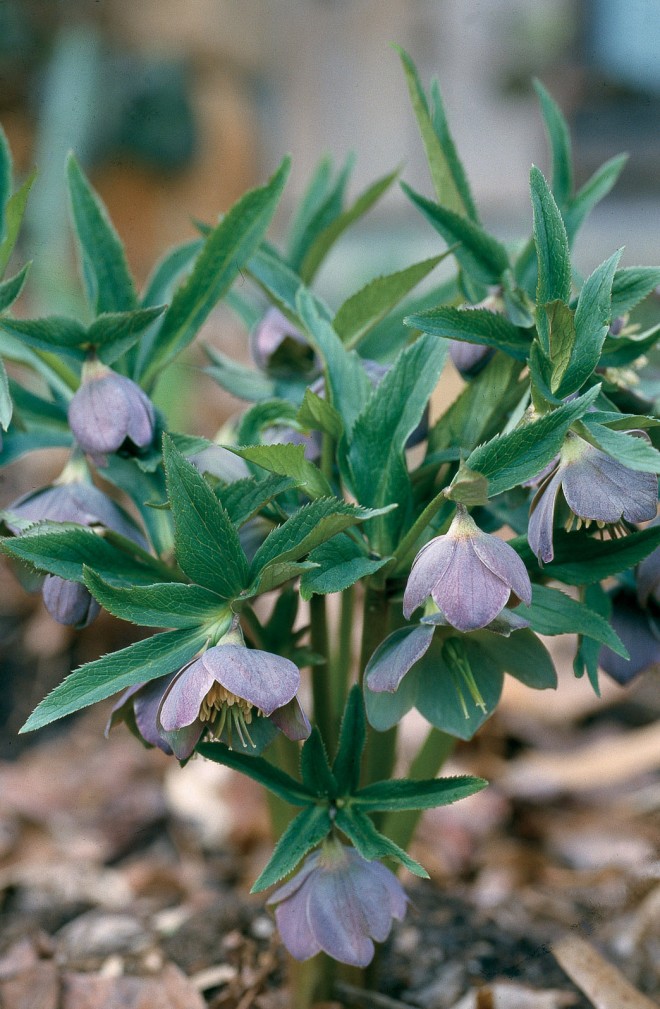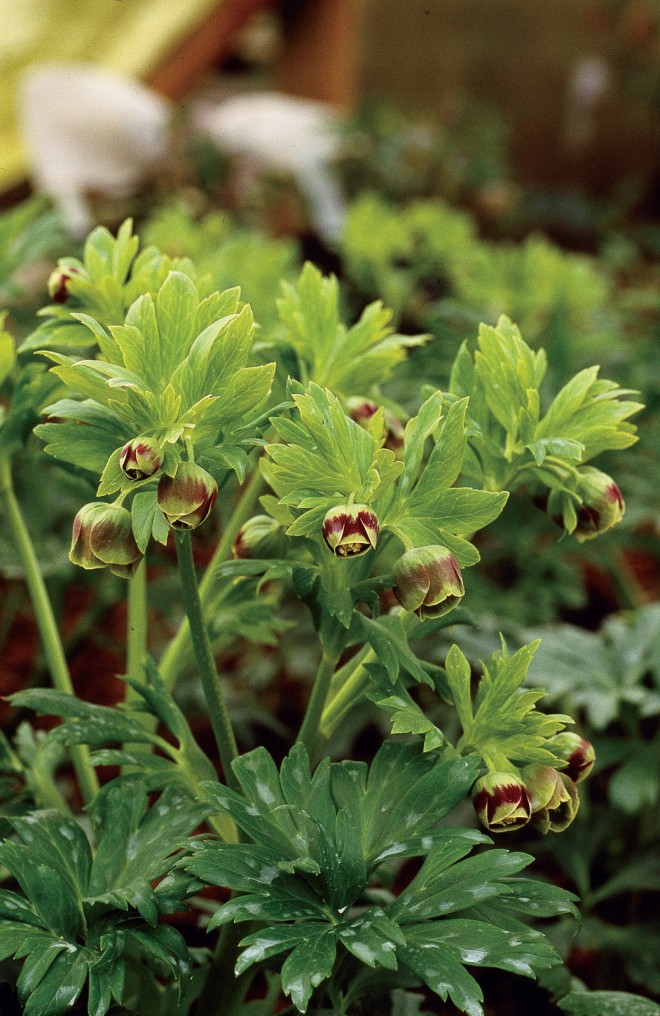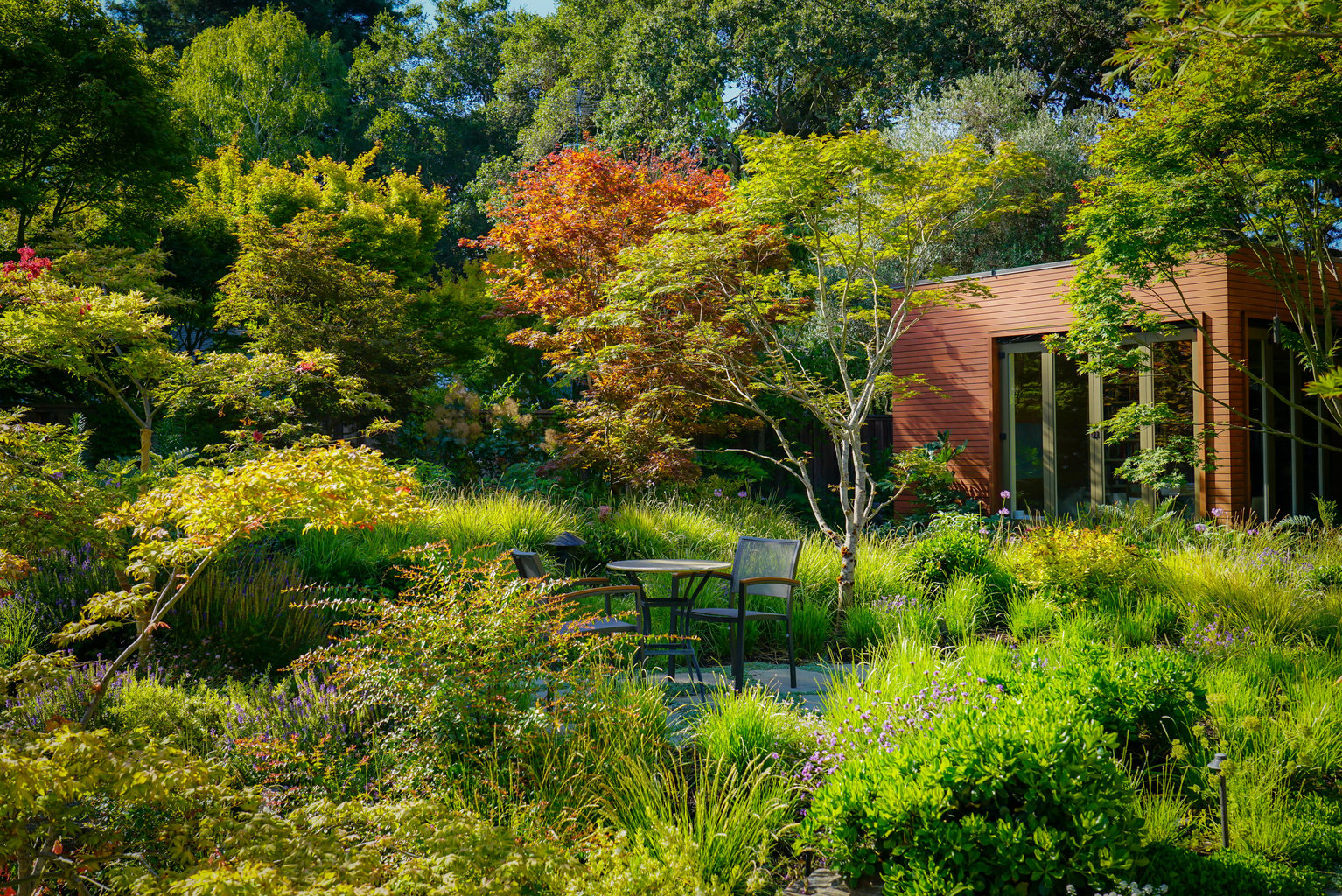

Contributor
- Topics: Archive

As it is currently described, the genus [Helleborus] contains seventeen species, though many subspecies and a few forms are recognized. As variation is the rule, two individuals of a species can be distinctly different in the color and size of the flower, as well as in the dissection and serration of the leaves.
Who could fail to be seduced by hellebores? They cast a spell from which you never awaken. Is it the flowers? They lack cloying fragrance, and many are small and subtly colored. Their precocious nature is part of their allure, but what makes them so much more than alluring? For many, hellebores are an obsession. They bloom for a month or more—longer where spring arrives slowly, and nights remain cool. Their rich green foliage provides summer and winter structure. It must be the sum of the parts: fantastic foliage, precocious bloom, and beautiful flowers. Alchemy creates the perfect temptress.
Most hellebores are native to mountainous regions of Europe, in open oak and beech woodlands, scrub, and meadows. These areas are characterized by limestone bedrock and calcareous, humus-rich soils. The center of distribution is the Balkan region of the former Yugoslavia, south along the eastern Adriatic to Greece and Turkey. One species, alone, is found far to the east in China.

Plants for Mediterranean California
Most of the caulescent (stemmed) hellebores and their hybrids are well adapted to Central and Southern California’s mediterranean climate, as well as the northern zones and temperate sections of the Pacific Northwest. Two of the three species originate on the dry, rocky islands of the Mediterranean Sea, including Corsica, Sardinia, and Majorca. In cultivation, they prefer a rich but well drained soil in full sun or light shade. Once established, they are moderately drought tolerant and grow vigorously for the first few years, although they are often short-lived. Their stems may flop in late summer or autumn, especially when grown in the shade, creating a wide, leafy mass that needs ample room. Spent stems can be cut to the ground as new growth emerges. These caulescent species self-sow sparingly, and most are hardy in USDA hardiness zones 7b to 10.
Corsican hellebore (Helleborus argutifolius) is a giant with erect stems topped by open clusters of stiff, three-lobed, coarsely saw-toothed leaves. The foliage is handsome and rivals the outfacing, apple green flowers in ornamental value. Flower buds emerge as early as December from the apex of the over-wintering, above-ground stems in dense, multi-flowered cymes. Mature plants can reach two-and-a half to three feet tall and three to four feet wide.

Several cultivars with variegated foliage have been introduced. ‘Janet Starnes’ is an eighteen- to twenty-four-inch selection produced both by seed and tissue culture. Its blue green leaves are heavily speckled with splashes of cream, and the new growth is often pink tipped. The flowers are pale chartreuse green. ‘Pacific Frost’ was found in the beautiful garden of Pam Frost near Vancouver, British Columbia. This seed strain produces stems of a similar height with heavy cream speckles and new growth tinted pink to rose. Neither of these selections is a strong grower. ‘Silver Lace’, from RD Plants Nursery in Devon, England, was first offered as ‘RD Silver’. Its new foliage appears with an overlay of cream veins on silvery green; leaves tend to green up as they mature.
The early flowers of stinking hellebore (Helleborus foetidus) never fail to delight. This voluminous species has spidery, black green, pedate leaves with five to ten, narrow toothed segments; the outermost segments may have three or more divisions. Large flower trusses are carried at the top of year-old stems. Each nodding, cylindrical flower is medium green, often with a red brown lip. The floral bracts become conspicuous in autumn, and buds often appear in December; January through March are the main flowering months. Mature clumps are multi-stemmed and several feet tall and wide; typically short-lived, they continue in the garden through their seedling offspring.
Of the many named cultivars, most have been selected for subtle variations in foliage characteristics; nearly all are propagated by seeds, resulting in offspring that can vary greatly.
‘Curio’ is a Natural Selection Nursery introduction, notable for the creamy white variegation of its leaves. The foliage of ‘Golden Showers’, introduced by Plant Delights Nursery, is green streaked with gold that extends up the petioles and into the flowers. From Northwest Garden Nursery in Eugene, Oregon, comes ‘Red Silver’, a compact selection (two to two-and-a half feet tall), with silvery foliage and red stems and petioles; red extends into the base of the flower.

Pine Knot Farms in Virginia has introduced several choice selections. ‘Gold Bullion’ is an extremely variable commercial seed strain, with foliage that varies from all gold to gold variegated, or green tipped and speckled with gold. Flowers are light primrose yellow. ‘Piccadilly’ is three feet tall with silvered foliage and red stems similar to the ‘Wester Flisk’ group; it is vigorous and adapted to warm regions. ‘Pine Knot Variegated’, grown from Phedar seed, produces eighteen- to twenty-four-inch tall plants that are heavily spotted and blotched with yellow and cream; its new and coldweather growth is often infused with pink.
From Phedar Research and Experimental Nursery in the UK comes ‘Green Giant’ strain, with light green foliage cut into many fine segments on four- to five-foot stems; flowers are pale green. ‘Ruth’ has deep, dark green foliage and heavy flower production. ‘Sienna’, found near Sienna, Italy, has black green foliage and pale chartreuse flowers. ‘Sophron’ comes from near Sophron, Hungary, with dark foliage overlaid with silver.
‘Italian Form’ is another large plant (to five feet tall) that produces many clusters of flowers. ‘Trasos-Montes’ is a seed strain from near the Spanish- Portuguese border; it has dark green, serrated leaves and flowers that lack the red lip.
The ‘Wester Flisk’ group seed strain, from the Firth of Tay, Scotland, has been popular for its gray green foliage with red stems and petioles, especially in winter. ‘Gertrude Jekyll’ (syn. ‘Miss Jekyll’s Scented’) offers a fragrance that varies from nose to nose.
Endemic to the island of Majorca, Helleborus lividus is the most tender of the hellebores; flower buds are killed at 10°F, though the plants usually survive. (Some believe that the hardier plants actually represent H. x sternii, a hybrid with Corsican hellebore.) Stiff, three-lobed, slaty green leaves are glossy and attractively mottled with cream or silver. The petioles and undersides of the leaves vary from rosy red to green. Outfacing, bowl-to saucer-like flowers are rose pink to madder, or occasionally silver green. Flowers widen and flatten as they age.

Hellebores for Modified Mediterranean Climates
The acaulescent European hellebores exhibit excellent hardiness and are remarkably drought tolerant, especially those from the eastern Adriatic and Mediterranean. In the wild, these species experience extended summer drought, high summer temperatures, and winter chilling. They grow in areas characterized by limestone bedrock, so thrive in humus-rich, well drained limy soil. In cultivation, they are widely tolerant of soils as long as they are rich and not too acidic. Choose a spot in sun or shade, as plants are widely adaptable.
Mature clumps exhibit many tightly packed stems and form leafy summer clumps. Where soil moisture and nutrition are ample, foliage may persist into winter. In southern California, the performance of most of these species remains largely untested. Plants that require winter chilling may not perform well in mild-winter regions; in the Pacific Northwest and other winter-wet areas, plants are susceptible to black spot and botrytis. These species are hardy in USDA zones 4 to 8.
Horticulture has muddied the identity of Helleborus atrorubens, a delicate purple to green flowered species from Eastern Europe. Plum- flowered selections of H. orientalis, sold as “atrorubens of gardens,” are significantly different from the true species, which is a quietly sophisticated plant, twelve to eighteen inches tall with open scapes bearing three-quarter-inch flowers on long peduncles. The deciduous, pedately divided leaves have five to fifteen divisions.
Helleborus cyclophyllus is a commanding and garden- worthy species with large apple green, often outfacing flowers on multi-stemmed clumps, eight to sixteen inches tall. Closely allied to H. odorus, some botanists consider it a southern expression of that species. The visible characters botanists use to distinguish this species are variable, and include the fully deciduous foliage of H. cyclophyllus, which, unlike H. odorus, emerges in spring coated in silken silvery hairs. In addition, the carpels are free at their bases, while those of H. odorus are usually fused.
Many consider Helleborus dumetorum only a collector’s plant; though it is far from showy, it has a quiet charm. The small green flowers are occasionally pale edged, almost like a frosted picotee. The flowering scapes bear conspicuous leafy bracts that add to the early display. Double-flowered selections occur in nature. The deciduous leaves often, but not consistently, resemble a horseshoe; emerging leaves are occasionally stained with deep red.
A variable but beautiful species, Helleborus multifidus is noteworthy for its delicately divided leaves and its apple to lime green flowers. Emerging leaves are often tinted red. Several subspecies are recognized that vary in height, flower size, and degree of leaf dissection. The base color of subspecies multifidus is green, but many individuals have red-edged or dark-tinted flowers that indicate affinity with H. torquatus; leaf dissection is variable, with many leaves showing sixty or more segments while others have just nine. The leaves of subspecies hercegovinus are dissected into a hundred or more thin ribbons. The subspecies istriacus and bocconei have the largest flowers.

Christmas rose (Helleborus niger) is celebrated in song and story, and it’s no wonder. Glistening white flowers open in winter, as early as January where the climate is benign. A few even open in late autumn. Unlike most hellebores, the flowers are borne on short, often naked stalks and they face outward. The sepals open white and slowly fade to green or burnished pink. An alpine plant, this is the most heat-sensitive species, and it often suffers from black spot in the winter-wet gardens of the Pacific Northwest.
Helleborus occidentalis is a delicate species recently split from the more robust H. viridis. In the garden, it offers a bit less punch than other green flowered species, yet it still has charms. It was one of the first widely cultivated species, due to an early and long medicinal history
The nearly two-inch, luminescent green to chartreuse flowers of Helleborus odorus nod from leafy scapes up to twenty inches tall. The flowers vary in fragrance from sweet to slightly skunky; some plants are completely scent free. The mostly evergreen, basal leaves have five main oval segments, with the outer ones divided variously to make up to eleven segments. Each leaflet is toothed on the upper third of its length. Newly emerging leaves are glabrous or sparsely clothed in hairs. Arguably, the most colorful and floriferous species is Lenton rose (Helleborus orientalis). Nodding bells dangle from the scapes like satin pulls on a Victorian window shade. The three subspecies vary in flower color and native range; all are garden worthy, but are devilishly hard to find in their pure forms, as they hybridize freely in the garden. Subspecies orientalis has large, white to creamy flowers, usually fading to green in the center; some flowers are pale yellow. Those of subspecies guttatus are white with maroon spots. The two may not be distinct botanically. The subspecies abchasicus (incorrectly referred to as “atrorubens of gardens”) is represented in gardens by clones known as ‘Early Purple’ group, with red-tinged new foliage and plumcolored flowers.
Foliage alone is reason enough to grow Helleborus purpurascens. The deeply divided, deciduous, palmate leaves are like origami parasols a foot or more tall. Some sport as many as thirty segments, while others have only ten. Dusty-plum, saucer-shaped, one-and-a-half- to two-inch blooms, borne singly or in threes, open as soon as they pierce the cool soil surface—as early as December in mild climates. Flower color varies from rich plum purple to sea green; the slaty color of modern hybrids comes in large part from this species.

A few years ago, Helleborus thibetanus was virtually unknown and completely unobtainable. Today, domestically propagated and imported plants are numerous. Though popular among enthusiasts, like most species, it has been slow to catch on in the nursery trade. This blowsy plant has white to pink, nodding to outfacing flowers with pointed sepals that deepen in color as they age. Plants go completely dormant in summer after flowering.
Finding a nursery that offers the exquisitely beautiful Helleborus torquatus is harder than choosing a winning lottery ticket. The deciduous, rounded leaves are elegantly divided into many linear, toothed segments. At its best, the flowers are deep plum purple inside and out. Most plants are rich purple outside and sea green inside with flaring sepals, but may be dull gray green. Plants with interior striping on the sepals also readily pass this trait to their hybrid progeny. This species is a major player in hybridizing programs, contributing the deep purple color, as well as the metallic sheen that creates “black” flowers.
Seedpods, rather than flowers, are the charm of Helleborus vesicarius. Inflated follicles hang like Chinese lanterns from the ten-inch scapes. The small green flowers are attractively banded with brick red, but they are often muddled with the leafy bracts. Soft, dissected leaves set off the flowers and seedpods. When seeds ripen in early summer, the pods fall off and roll away like tumbleweeds, after which the plant goes completely dormant. This species is difficult to cultivate, as it needs dry summers and a deep winter chilling.
Helleborus viridis is a variable species distributed in western and central Europe; the outstanding forms are gorgeous. Nodding, deep apple green flowers are one to two inches across in groups of two to four. The stiff, lustrous, deciduous foliage has up to thirteen divisions and is coarsely saw-toothed. The leaves stand up to a foot high and are striking with sedges and ferns in the summer garden.
Adapted from Hellebores: A Comprehensive Guide, by C Colston Burrell and Judith Knott Tyler, published by Timber Press in 2006. Part 2, focusing on the hybrids, will appear in a future issue of Pacific Horticulture.
Share:
Social Media
Garden Futurist Podcast
Most Popular
Videos
Topics
Related Posts

Low Maintenance Gardens – Better for Pollinators and People
Autumn 2022 “I come out every day. It’s therapy, my meditation.” Janet’s young garden transformed from overgrown, invasive plants to mostly natives. The dailiness of

Invasive Plants Are Still Being Sold: Preventing Noxious Weeds in Your Landscape
Autumn 2022 With so many beautiful ornamental plant species and cultivars throughout California and the Pacific Northwest, how do you decide which ones to include

Garden Design in Steppe with Transforming Landscapes with Garden Futurist Emmanuel Didier
Summer 2022 Listen to full Garden Futurist: Episode XVII podcast here. Emmanuel Didier, Principal and Creative Director at Didier Design Studio is a leading figure

Seslerias: Versatile Groundcover Meadow Grasses
Summer 2022 Without question, the most beautiful and versatile of all the groundcover meadow grasses are the moor grasses (Sesleria). Moor grasses tick off all









